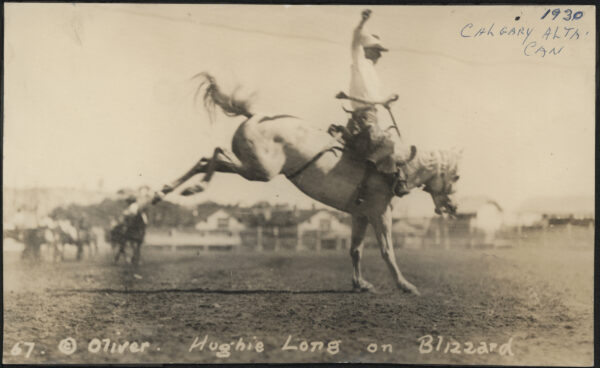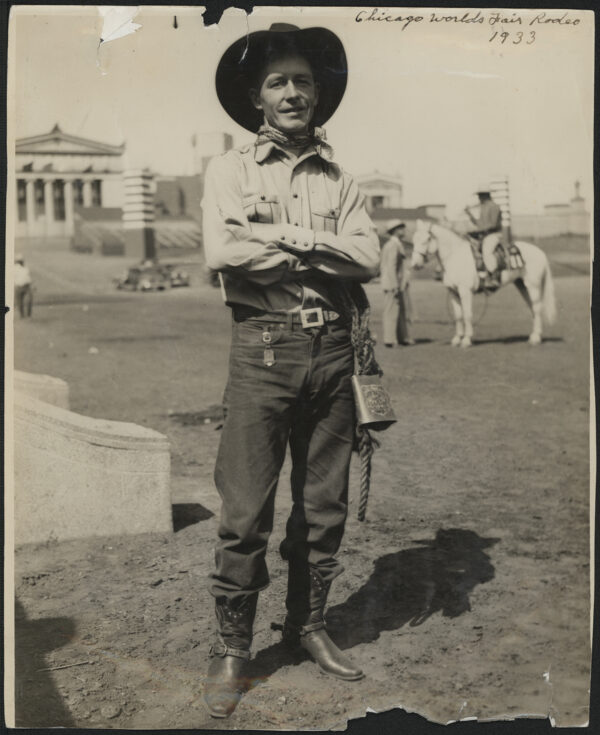By Tom Reardon
Considering Hughie Long’s traumatic childhood, he could have been a sour, bitter person. Instead, he took a path that led to three Hall of Fame inductions, and there’s a road in Cresson, Texas, named in his honour.

He was born in Battleford, Saskatchewan, in 1907. His family had a farm west of Battleford near Prongua. (Pronounced Prong-y) His father, Joe Long, was a Mountie for 12 years. He went to Africa for the Boer War portion of WWI and left his wife, Sarah, and nine kids to keep the place operating.
Hughie’s mother, Sarah Long, died when he was 11. Out of necessity, he and his siblings ran the farm and household. When his father returned from the war, he promptly gave away the entire family. Hughie was sent to live with a homesteader several miles away. He said, “The work was hard, although it didn’t hurt me a bit.” His wife Helen added, “but Hughie was doing all the work, and he didn’t like that.” Before he left, he and a neighbour kid had “our own little bronc bustings” when the farmer was gone to town. At 14, he finished the third grade; that was his last formal education.
In an interview many years later, Helen summed it up best. “What was sad was that he’d been gone, out in the middle of nowhere, for two years, and there’d been nobody to wonder where he was, to wish he’d come home, to care about how he was doing.”
In 1924 he worked on the Sweetgrass Reserve Ranch, riding fences and checking cows. That ranch was just west of Prongua. He entered his first rodeo that summer and two years later, at 19 years of age, won the Saskatchewan Bronc Riding Championship.
His prowess on a bucking horse caught the attention of Leon Lamar, who owned two ‘Wild West’ shows. After a short stay with Lamar, Hughie signed on with a show owned by Shakey Davis. Evidently, the meals served by Davis’ cook left a lot to be desired. Hughie once told a friend, “As much as possible, we ate out. We slept out too — out in the open.”
“What was sad was that he’d been gone, out in the middle of nowhere, for two years, and there’d been nobody to wonder where he was…”
Hughie was billed as “The Prongy Kid”. It was misspelt, but it was easy to pass him off as a kid because of his slight stature. Years later, Helen said, “He was jockey-size almost, a little bigger.”

After Davis, Hughie was free to enter wherever he wanted, and in 1931 he won the bareback riding and placed in the bull riding at Chicago, New York and Boston, the three biggest shows in the nation. At an invitational 21-day rodeo held in conjunction with the 1933 Chicago World’s Fair, he finished second in the bareback and third in the bull riding. There were few records kept in those days, but Hughie was regularly in the prize money. He was in Boston in 1936 when the Cowboy Turtle Association was formed. Despite his lack of education, Hughie was responsible for writing the basic rules of bareback riding and bull riding, many of which are still used in today’s Professional Rodeo Cowboys Association.
About this time, Hughie’s life changed course. He was hanging around a saddle shop in Cresson when a couple of ranchers offered to pay his entry fees in a rodeo at the Stock Show in Fort Worth. They bargained for the percentage he’d pay them if he cashed, which he did. When he returned to square up with them, one of the ranchers asked him if he’d break five colts for him. He did, and when he delivered the steeds, they all had a good handle and worked a rope. Word spread, and suddenly, a lot of people wanted him to train a horse. He still rodeoed, but he had outside horses to ride, so he bought a house and built a barn between the Baptist and Methodist churches in Cresson. For the first time in a long while, “The Prongy Kid” had a place called home.

In 1943, he worked as a mounted guard at the Bluebonnet Bomb Plant and in 1944 when Uncle Sam called, Hughie, 37, joined the Army. He was stationed at a nearby base which (with a weekend pass) enabled him to return to Cresson to work with numerous reining horses he owned. Shortly after he received orders for overseas duty, the war ended, and Private Long was discharged. In the years that followed, he owned, co-owned or trained numerous Quarter Horses that won Registers of Merit.
Helen Long came into the picture in 1950, and as Hughie aged, he eased into giving riding lessons, worked with 4-H kids, and became an American Quarter Horse Association certified judge. He judged competitions and horse shows around Texas for 20 years.
Hughie was inducted into the Texas Rodeo Cowboy Hall of Fame in 1978, the Rodeo Hall of Fame in the National Cowboy & Western Heritage Museum in Oklahoma City in 1984 and the Canadian Pro Rodeo Hall of Fame in 1987.
“The Prongy Kid” passed away in late 1987. He is buried in Cresson Cemetery, not far from Hughie Long Road.















